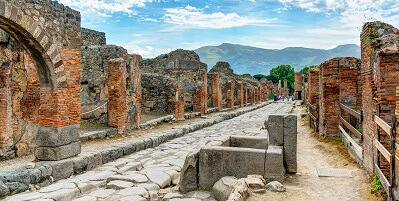The Most Recent Eruption of Mt. Vesuvius
The ancient volcano who froze a whole civilisation in time still stands today looming over Pompei and its neighbouring towns. Did you know it has erupted multiple times since 79 AD?
History of Mount Vesuvius
Mount Vesuvius has been silent for 75 years, but is watched around the clock. Labelled highly reactive by scientists the volcano is overdue an eruption, threatening to once again destroy its surrounding towns, just like it did thousands of years ago. Unlike our ancient brothers and sisters however, we have the pre-knowledge and warning that they did not. This should mean the people of Naples should be safe far in advance of any eruption.
No other volcano in the world has perhaps received the same infamous reputation as that of Mount Vesuvius. An active volcano, it has experienced 8 major eruptions in its lifespan and erupted 30 times since the fateful day at Pompeii. It is particularly important that geologists and volcanologists continue to research Vesuvius as it is part of the Campanian Volcanic arc, a series of volcanos in the region that connect to each other. Researchers have reason to believe that the next eruption will be a Plinian one, meaning that fast-moving lava, noxious gases, and rocks could very easily rain havoc on the towns below.
Last Major Eruption- 1944
In the midst of World War II, the events of March 17th, 1944 were not highly publicised until months later, which shows just how out of place and tense the conditions were during wartime. Though the residents of San Sebastiano were already dealing with the effects of invasions and bombings, the terror was not yet over. Starting on the 17th of March and lasting for a week and a half, a slow-moving lava flow, rock and ash hailed down on the city, destroying it. As the Italian government was in shambles during the war, it was American allied forces that dealt with the management of evacuating the 7,000 townspeople out of harm’s way. In fact, the way in which the United States forces took control of the situation was so well that only 26 civilians died, however, there were 12,000 people displaced.
On the other side of the Vesuvius, at first, the 39th Bombardment Group were not too troubled by the mountainous eruption, believing it would not affect them. However, they soon realized that the threat was imminent than previously imagined, so the group was evacuated. No military deaths occurred during the eruption, however, 25 million dollars’ worth of aircraft was destroyed, more than what would occur in future Nazi raids. The fall out of this was that news spread to the Germans who believed that the entire squadron had been wiped out. But in fact, the 39th Bombardment Group had survived and was relocated to a different area unbeknownst to the Germans.
The Famous Pompeii
Easily the most famous of all eruptions worldwide is that of 79AD, whereby the city of Pompeii and neighbouring town Herculaneum were destroyed. In just 25 hours, the town was buried under ash from pyroclastic flows that plummeted down the mountain, leaving Pompeii abandoned but perfectly intact. It wasn’t until the 1700’s that the city and some of its 2,000 residents that were killed in its demise were discovered and subsequently excavated.
Today Pompeii is visited annually by over 2 million visitors who are intrigued by the lifestyle of wealthy Roman citizens whose holiday villas lined the streets of the city, and the dubious frescoes of the city’s brothel; Lupanar.
Vesuvius Today
So, what does the future of Mount Vesuvius hold for its surroundings? Its silence for the last 75 years may have an ominous warning. Vesuvius is still very much an active stratovolcano, with the city of Naples and its 3 million residents only a mere 12 kilometres away. The fact that the city could be destroyed in 2 and a half minutes makes it the volcano one of the most studied and precariously watched in the world. This brings some comfort as because of all the research being done, authorities have evacuation plans in action that will see the 600,000 residents living in the ‘red zone’ being evacuated at least 72 hours before any major seismic activity. The government is already taking precautionary approaches to protecting both the infrastructure and citizens on the area by trying to make a national park around Vesuvius to stop from anything being built on the land nearby, and offering those who live on the base of the mountain monetary funds to assist in relocating to a safer area. The efforts to monitor the activity of the volcanos are underway at the Vesuvius Observatory where seismic activity is closely watched.
Whilst these efforts are being administered, there are a multitude of visitors that come to see what the destruction of Vesuvius did to Pompeii. Many come to see the ancient ruins and are astounded by the beauty of the picturesque mountain that can be seen looming in the distance.
Related article: How do you get to Mount Vesuvius from Pompeii?
















